Hyperspectral Inversion Model of Relative Heavy Metal Content in Pennisetum sinese Roxb via EEMD-db3 Algorithm
Abstract
1. Introduction
2. Materials and Methods
2.1. Method of Obtaining PsR Sample
2.2. Hyperspectral Data Acquisition and Heavy Metal Content Determination
2.3. Spectra Pretreatment
2.4. Inversion Data Selection Method
2.5. Model Building and Evaluation Methods
3. Results
3.1. Heavy Metal Accumulation Performance
3.2. Construction of Inverse Model for Relative Contents of Heavy Metals
4. Discussion
5. Conclusions
Author Contributions
Funding
Acknowledgments
Conflicts of Interest
References
- Li, Q.; Xiao, Y.; He, J.; Ma, C.; Pan, C.; Zhang, Y. Effects of cadmium on the growth of imperial bamboo grass and its cadmium absorption and accumulation. Jiangsu Agric. Sci. 2012, 40, 354–356. [Google Scholar]
- He, L.; Zhu, Q.; Wang, Y.; He, M.; Tan, F. Advances in research on the comprehensive utilization of a perennial grass Pennisetum hydridum. Chin. J. Appl. Environ. Biol. 2020, 26, 705–712. [Google Scholar]
- Tan, F.; He, L.; Zhu, Q.; Wang, Y.; Chen, C.; He, M. Pennisetum hydridum: A Potential Energy Crop with Multiple Functions and the Current Status in China. Bioenerg. Res. 2022, 15, 850–862. [Google Scholar] [CrossRef]
- Hei, L.; Lee, C.C.; Wang, H.; Lin, X.Y.; Chen, X.; Wu, Q. Using a high biomass plant Pennisetum hydridum to phyto-treat fresh municipal sewage sludge. Bioresour. Technol. 2016, 217, 252–256. [Google Scholar] [CrossRef]
- Li, D.; Lai, C.; Li, Y.; Li, H.; Chen, G.; Lu, Q. Biochar improves cd-contaminated soil and lowers Cd accumulation in Chinese flowering cabbage (Brassica parachinensis L.). Soil Tillage Res. 2021, 213, 105085. [Google Scholar] [CrossRef]
- Hu, L.; Wang, R.; Liu, X.; Xu, B.; Xie, T.; Li, Y.; Wang, M.; Wang, G.; Chen, Y. Cadmium phytoextraction potential of king grass (PsR.) and responses of rhizosphere bacterial communities to a cadmium pollution gradient. Environ. Sci. Pollut. Res. Int. 2018, 25, 21671–21681. [Google Scholar] [CrossRef]
- Alkharabsheh, H.M.; Seleiman, M.F.; Battaglia, M.L.; Shami, A.; Jalal, R.S.; Alhammad, B.A.; Almutairi, K.F.; Al-Saif, A.M. Biochar and Its Broad Impacts in Soil Quality and Fertility, Nutrient Leaching and Crop Productivity: A Review. Agronomy 2021, 11, 993. [Google Scholar] [CrossRef]
- Kathrin, W.; Peter, Q. Properties of biochar. Fuel 2018, 217, 240–261. [Google Scholar]
- Wen, Y.; Yang, L.Q.; He, L.P. Pollution, Metabolism and Safety Control of Heavy Metals in Livestock Production. Chin. J. Anim. Sci. 2021, 57, 61–66. [Google Scholar]
- Zhao, Y.W.; Li, Y.P.; Duan, S.R.; Nan, J.B.; Zhao, Y.L.; Zhao, H.Y. Correlation between Heavy Metal Distribution in Tissue of Livestock in Mining Area in Central Tibet and the Breeding Environment. Chin. J. Anim. Sci. 2020, 41, 62–67. [Google Scholar]
- Tian, J.; Li, Y.; Zhang, K.; Wang, G.; Xia, Y.; Yu, E.; Li, Z.; Gong, W.; Xie, J. Dietary PsR meal reduces lipid accumulation and alleviates enteritis in juvenile grass carp, Ctenopharyngodon idella. Aquac. Rep. 2021, 21, 100915. [Google Scholar] [CrossRef]
- He, Y.; Lu, L.; Peng, C.; Li, H.; Zhang, J.; Li, R.; Zhou, C. High-yield grass PsR plantation and organic manure alter bacterial and fungal communities structure in an ecological agriculture farm. AMB Express 2020, 10, 1–14. [Google Scholar] [CrossRef] [PubMed]
- Huang, Z.; Zhu, Z.; Wu, X.; Lai, X.; Wang, P.; Hu, X.; Cui, L. Adsorption of heavy metals by biochar derived from PsR. Environ. Chem. 2016, 35, 766–772. [Google Scholar]
- Yi, Z.; He, J.; Cheng, H.; Luo, S.; He, H.; Zhang, W.; Zhang, Z.; Li, H. Effects of Cd polluted soil on the modular growth and physiological characteristics of Pennisetum hydridum. J. Agro-Environ. Sci. 2014, 33, 276–282. [Google Scholar]
- Zheng, J.; Xia, C.; Li, F. Study on the effects of heavy metals elements on animals and ecological environment. Feed Res. 2020, 43, 152–157. [Google Scholar]
- Li, J.H.; Wang, J.; Peng, H.; Hu, Y.; Su, H. Fuzzy-torque approximation-enhanced sliding mode control for lateral stability of mobile robot. IEEE Trans. Syst. Man Cybern. Syst. 2021, 52, 2491–2500. [Google Scholar] [CrossRef]
- Li, J.H.; Wang, J.; Peng, H.; Zhang, L.; Hu, Y.; Su, H. Neural fuzzy approximation enhanced autonomous tracking control of the wheel-legged robot under uncertain physical interaction. Neurocomputing 2020, 410, 342–353. [Google Scholar] [CrossRef]
- Li, J.H.; Dai, Y.; Wang, J.; Su, X.; Ma, R. Towards Broad Learning Networks on Unmanned Mobile Robot for Semantic Segmentation. In Proceedings of the 2022 International Conference on Robotics and Automation (ICRA), Philadelphia, PA, USA, 23–27 May 2022; pp. 9228–9234. [Google Scholar]
- Li, J.H.; Wang, J.; Wang, S.; Yang, C. Human–robot skill transmission for mobile robot via learning by demonstration. Neural Comput. Appl. 2021, 22, 1–11. [Google Scholar] [CrossRef]
- Luo, X.W.; Liao, J.; Zang, Y.; Ou, Y.G.; Wang, P. Developing from Mechanized to Smart Agricultural Production in China. Strateg. Study CAE 2022, 24, 46–54. [Google Scholar] [CrossRef]
- Yuan, Y.; Zheng, X.; Lu, X. Discovering diverse subset for unsupervised hyperspectral band selection. IEEE Trans. Image Process. 2016, 26, 51–64. [Google Scholar] [CrossRef]
- Yu, F.H.; Xing, S.M.; Guo, Z.H.; Bai, J.C.; Xu, T.Y. Remote sensing inversion of the nitrogen content in rice leaves using character transfer vegetation index. Trans. Chin. Soc. Agric. Eng. 2022, 38, 175–182. [Google Scholar]
- Li, C.; Cui, Y.; Ma, C.; Niu, Q.; Li, J. Hyperspectral inversion of maize biomass coupled with plant height data. Crop Sci. 2021, 61, 2067–2079. [Google Scholar] [CrossRef]
- Miraglia, T.; Adeline, K.; Huesca, M.; Ustin, S.; Briottet, X. Monitoring LAI, chlorophylls, and carotenoids content of a woodland savanna using hyperspectral imagery and 3D radiative transfer modeling. Remote Sens. 2019, 12, 28. [Google Scholar] [CrossRef]
- Xue, Y.; Zou, B.; Wen, Y.; Tu, Y.; Xiong, L. Hyperspectral Inversion of Chromium Content in Soil Using Support Vector Machine Combined with Lab and Field Spectra. Sustainability 2020, 12, 4441. [Google Scholar] [CrossRef]
- Liu, H.; Yu, T.; Hu, B.; Hou, X.; Zhang, Z.; Liu, X.; Liu, J.; Wang, X.; Zhong, J.; Tan, Z.; et al. Uav-borne hyperspectral imaging remote sensing system based on acousto-optic tunable filter for water quality monitoring. Remote Sens. 2021, 13, 4069. [Google Scholar] [CrossRef]
- Gu, X.; Wang, Y.; Sun, Q.; Yang, G.; Zhang, C. Hyperspectral inversion of soil organic matter content in cultivated land based on wavelet transform. Comput. Electron. Agric. 2019, 167, 105053. [Google Scholar] [CrossRef]
- Liu, Z.; Lu, Y.; Peng, Y.; Zhao, L.; Wang, G.; Hu, Y. Estimation of Soil Heavy Metal Content Using Hyperspectral Data. Remote Sens. 2019, 11, 1464. [Google Scholar] [CrossRef]
- Yang, X.; Lei, S.; Zhao, Y.; Cheng, W. Use of hyperspectral imagery to detect affected vegetation and heavy metal polluted areas: A coal mining area, China. Geocarto Int. 2022, 37, 2893–2912. [Google Scholar] [CrossRef]
- Chen, Z.; Liu, Q.; Yin, W.; Liu, H.; Yang, Y. Visualization of petroleum hydrocarbon content in latosol based on hyperspectral imaging technology. Spectrosc. Spectr. Anal. 2018, 38, 2916–2922. [Google Scholar]
- Cao, Y.; Jiang, K.; Wu, J.; Yu, F.; Du, W.; Xu, T. Inversion modeling of japonica rice canopy chlorophyll content with UAV hyperspectral remote sensing. PLoS ONE 2020, 15, e0238530. [Google Scholar] [CrossRef]
- Wu, W.; Li, J.; Zhang, Z.; Ling, C.; Lin, X.; Chang, X. Estimation model of LAI and nitrogen content in tea tree based on hyperspectral image. Trans. Chin Soc. Agric. Eng. 2018, 34, 195–201. [Google Scholar]
- Feng, S.; Itoh, Y.; Parente, M.; Duarte, M.F. Hyperspectral band selection from statistical wavelet models. IEEE Trans. Geosci. Remote Sens. 2017, 55, 2111–2123. [Google Scholar] [CrossRef]
- Zhang, S.; Shen, Q.; Nie, C.; Huang, Y.; Wang, J.; Hu, Q.; Ding, X.; Zhou, Y.; Chen, Y. Hyperspectral inversion of heavy metals content in reclaimed soil from a mining wasteland based on different spectral transformation and modeling methods. Spectrochim. Acta Part A Mol. Biomol. Spectrosc. 2019, 211, 393–400. [Google Scholar] [CrossRef]
- Cao, C.; Wang, T.; Gao, M.; Li, Y.; Li, D.; Zhang, H. Hyperspectral inversion of nitrogen content in maize leaves based on different dimensionality reduction algorithms. Comput. Electron. Agric. 2021, 190, 106461. [Google Scholar] [CrossRef]
- Guo, F.; Xu, Z.; Ma, H.; Liu, X.; Tang, S.; Yang, Z.; Zhang, L.; Liu, F.; Peng, M.; Li, K. Estimating chromium concentration in arable soil based on the optimal principal components by hyperspectral data. Ecol. Indic. 2021, 133, 108400. [Google Scholar] [CrossRef]
- Huang, N.E.; Shen, Z.; Long, S.R.; Wu, M.C.; Shih, H.H.; Zheng, Q.; Yen, N.; Tung, C.C.; Liu, H.H. The empirical mode decomposition and the Hilbert spectrum for nonlinear and non-stationary time series analysis. Proc. R. Soc. Lond. Ser. A Math. Phys. Eng. Sci. 1998, 454, 903–995. [Google Scholar] [CrossRef]
- Smulko, J. Methods of trend removal in electrochemical noise data–Overview. Measurement 2019, 131, 569–581. [Google Scholar]
- Li, M.; Zhao, Y.; Cui, F.; Liu, L. Research on Raman Spectral Signal Characteristics Based on Ensemble Empirical Mode Decomposition. Spectrosc. Spectr. Anal. 2020, 40, 54–58. [Google Scholar]
- Zhuo, W.; Shi, R.; Zhang, C.; Gao, W.; Liu, P.; Wu, N.; Tao, Z. A novel method for leaf chlorophyll retrieval based on harmonic analysis: A case study on Spartina alterniflora. Earth Sci. Inform. 2020, 13, 747–762. [Google Scholar] [CrossRef]
- Zhao, X.; Liu, Z.; He, Y.; Zhang, W.; Tong, L. Study on early rice blast diagnosis based on unpre-processed Raman spectral data. Spectrochim. Acta Part A Mol. Biomol. Spectrosc. 2020, 234, 118255. [Google Scholar] [CrossRef]
- Li, J.; Tong, Y.; Guan, L.; Wu, S.; Li, D. A UV-visible absorption spectrum denoising method based on EEMD and an improved universal threshold filter. RSC Adv. 2018, 8, 8558–8568. [Google Scholar] [CrossRef] [PubMed]
- Cui, L.; Dou, Z.; Liu, Z.; Zuo, X.; Lei, Y.; Li, J.; Zhao, X.; Zhai, X.; Pan, X.; Li, W. Hyperspectral inversion of phragmites communis carbon, nitrogen, and phosphorus stoichiometry using three models. Remote Sens. 2020, 12, 1998. [Google Scholar] [CrossRef]
- Wu, W.B.; Tang, T.; Gao, T.; Han, C.Y.; Li, J.; Zhang, Y.; Wang, X.Y.; Wang, J.W.; Feng, Y.J. Spectral diagnostic model for agricultural robot system based on binary wavelet algorithm. Sensors 2022, 22, 1822. [Google Scholar] [CrossRef]
- Zhang, J.; Xi, L.; Yang, X.Y.; Xu, X.; Guo, W.; Cheng, T.; Ma, X.M. Construction of hyperspectral estimation model for organic matter content in sandy ginger black soil. Trans. CSAE 2020, 36, 135–141. [Google Scholar]
- Yan, P.; Shang, S.; Zhang, C.; Zhang, X. Classification of coal mine water sources by improved BP neural network algorithm. Spectrosc. Spectr. Anal. 2021, 41, 2288–2293. [Google Scholar]
- Duan, M.; Xie, Z.N.; Li, X.K. Multi-point wind pressure signal preprocessing approach based on SYM wavelet and its application. J. Vib. Shock. 2013, 32, 50–55. [Google Scholar]
- Zhang, C.; Zhou, L.; Zhao, Y.; Zhu, S.; Liu, F.; He, Y. Noise reduction in the spectral domain of hyperspectral images using denoising autoencoder methods. Chemom. Intell. Lab. Syst. 2020, 203, 104063. [Google Scholar] [CrossRef]
- Wu, Y.; Zhang, X. Curve fairing algorithm based on ensemble empirical mode decomposition and singular spectrum analysis. Comput. Integr. Manuf. Syst. 2020, 26, 3258–3267. [Google Scholar]
- Xu, M.; Sun, J.; Zhou, X.; Tang, N.; Shen, J.; Wu, X. Research on nondestructive identification of grape varieties based on EEMD-DWT and hyperspectral image. J. Food Sci. 2021, 86, 2011–2023. [Google Scholar] [CrossRef]
- Liu, W.; Sun, H.; Yang, X.; Dong, J. Spectral Reflectance Characteristics of Alpine Grassland Based on Derivative and Logarithmic Transform Spectra-Take HJ-1A/HSI Images of Naqu Prefecture as an Example. Spectrosc. Spectr. Anal. 2020, 40, 2200–2207. [Google Scholar]
- Li, C.C.; Chen, P.; Lu, G.Z.; Ma, C.Y.; Ma, X.X.; Wang, S.T. The inversion of nitrogen balance index in typical growth period of soybean based on high definition digital image and hyperspectral data on unmanned aerial vehicles. J. Appl. Ecol. 2018, 29, 1225–1232. [Google Scholar]
- Wang, Y.; Yang, X.; Zhao, Q.; Gu, X.; Guo, C.; Liu, Y. Quantitative Inversion of Soil Organic Matter Content in Northern Alluvial Soil Based on Binary Wavelet Transform. Spectrosc. Spectr. Anal. 2019, 39, 2855–2861. [Google Scholar]
- Tang, H.; Meng, X.; Su, X.; Ma, T.; Liu, H.; Bao, Y.; Zhang, M.; Zhang, X.; Huo, H. Hyperspectral prediction on soil organic matter of different types using CARS algorithm. Trans. CSAE 2021, 37, 105–113. [Google Scholar]
- Thorp, K.R.; Gore, M.A.; Andrade-Sanchez, P.; Carmo-Silva, A.E.; Welch, S.M.; White, J.W.; French, A.N. Proximal hyperspectral sensing and data analysis approaches for field-based plant phenomics. Comput. Electron. Agric. 2015, 118, 225–236. [Google Scholar] [CrossRef]
- Lv, M.; Ren, G.; Li, X.; Fan, P.; Sun, Z.; Hou, G.; Liu, Y. Prediction of Organic Carbon Content of Intertidal Sediments Based on Visible-Near Infrared Spectroscopy. Spectrosc. Spectr. Anal. 2020, 40, 1082–1086. [Google Scholar]
- Wang, X.N.; Yi, Z.C.; Zhang, Y.F.; Wang, J.Q.; Zhang, Y.J.; Li, H.S. Responses and Remediating Effects of Pennisetum hydridum to Application of Heavy-Metals-Contaminated Chicken Manures and Sewage Sludges. J. Agric. Resour. Environ. 2015, 32, 477–484. [Google Scholar]
- Sun, A.; Deng, H.F.; He, F.; Li, H.B.; Luo, Y.; Huan, C.; Li, S.; Yi, K.L.; Li, J.B. Experimental Study on the accumulation of heavy metals in different parts of forage under heavy metal pollution environment. Fresenius Environ. Bull. 2021, 30, 10690–10696. [Google Scholar]
- Li, M.; Li, Y.B.; Zhang, Q.C.; Shi, Y.T.; Cui, F.P.; Zhao, Y. Research on Spark Spectrum Signal Processing Based on Ensemble Empirical Mode Decomposition. Spectrosc. Spectr. Anal. 2020, 40, 1923–1928. [Google Scholar]
- Peng, J.; He, Y.; Ye, L.; Shen, T.; Liu, F.; Kong, W.; Liu, X.; Zhao, Y. Moisture influence reducing method for heavy metals detection in plant materials using laser-induced breakdown spectroscopy: A case study for chromium content detection in rice leaves. Anal. Chem. 2017, 89, 7593–7600. [Google Scholar] [CrossRef]
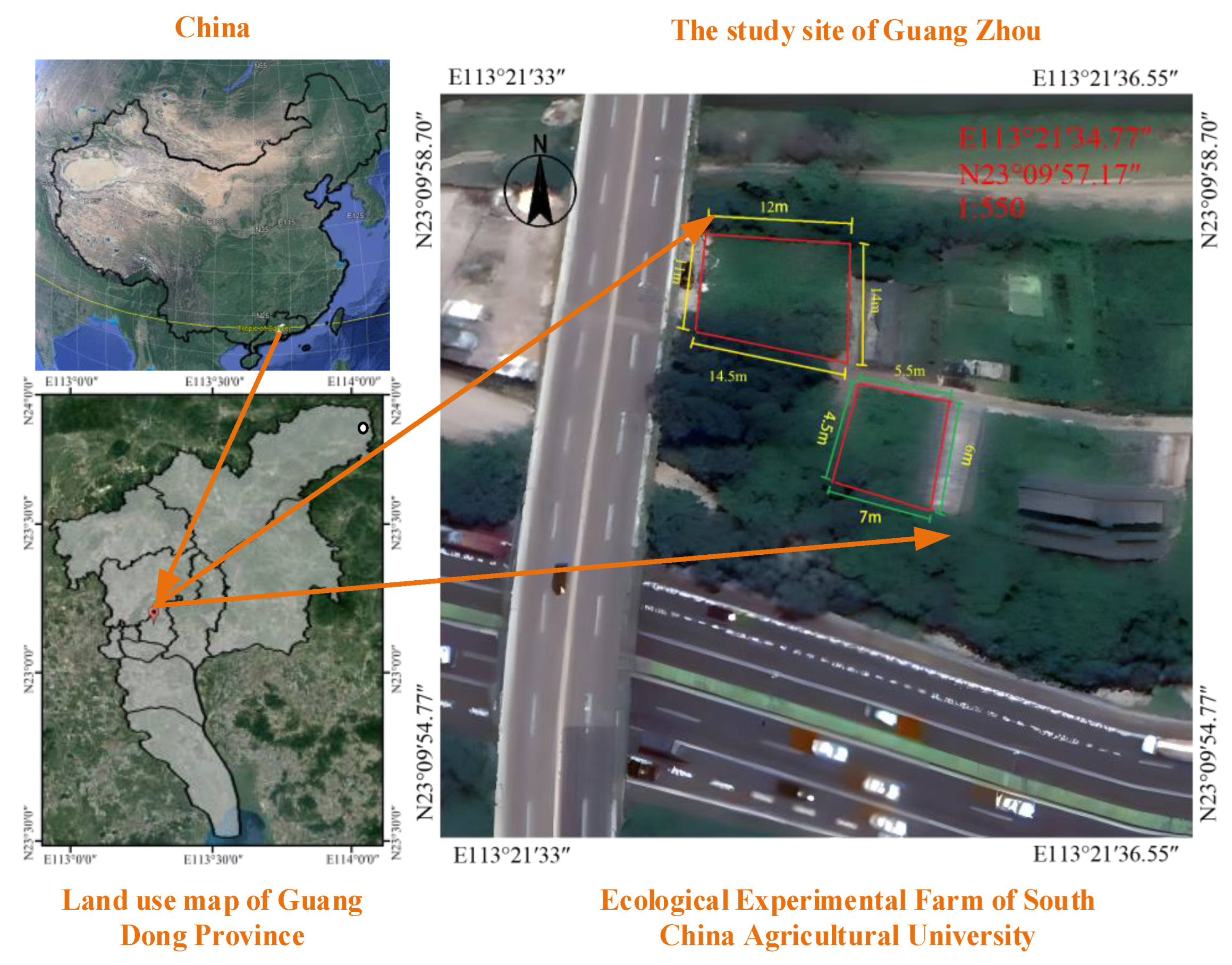
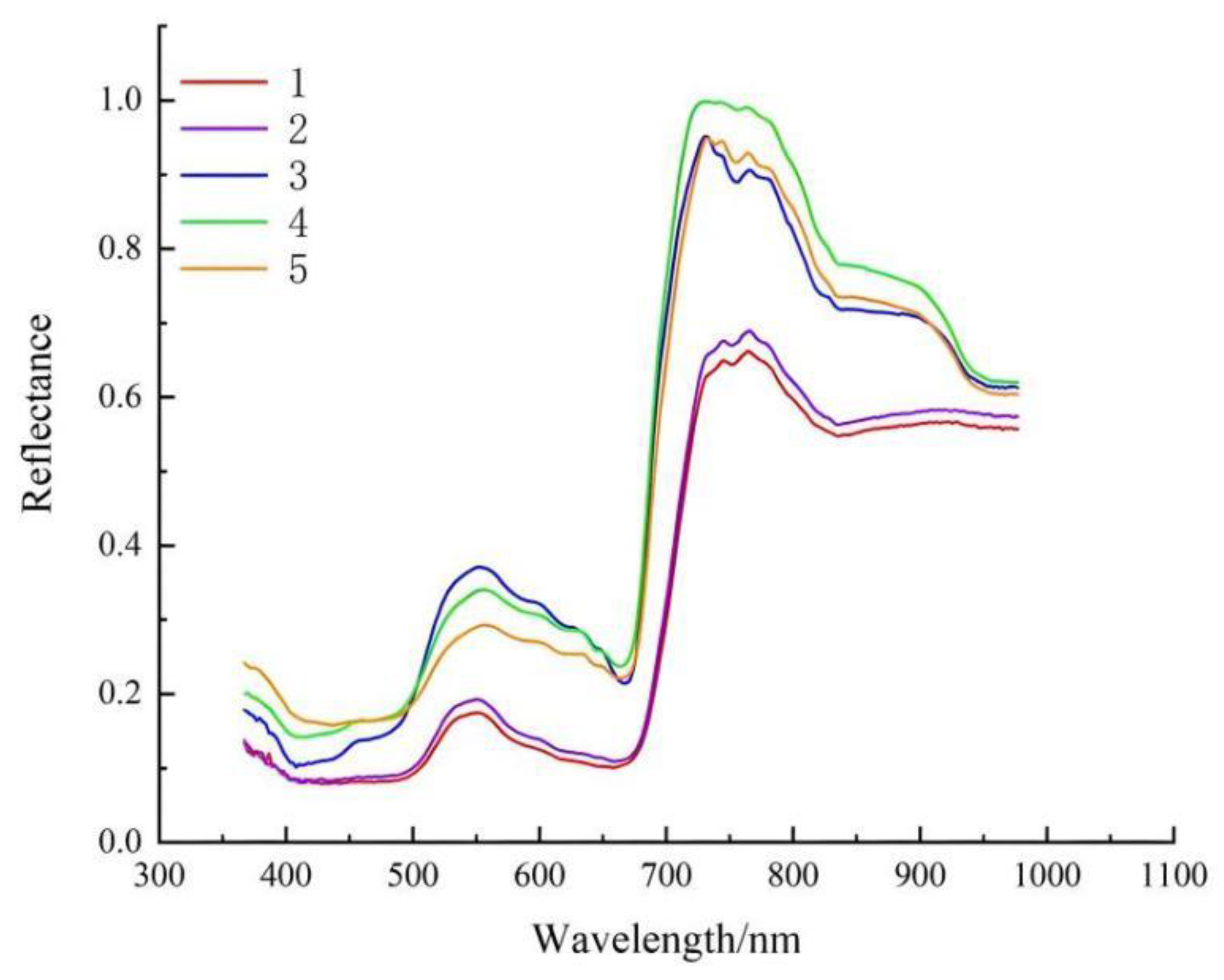

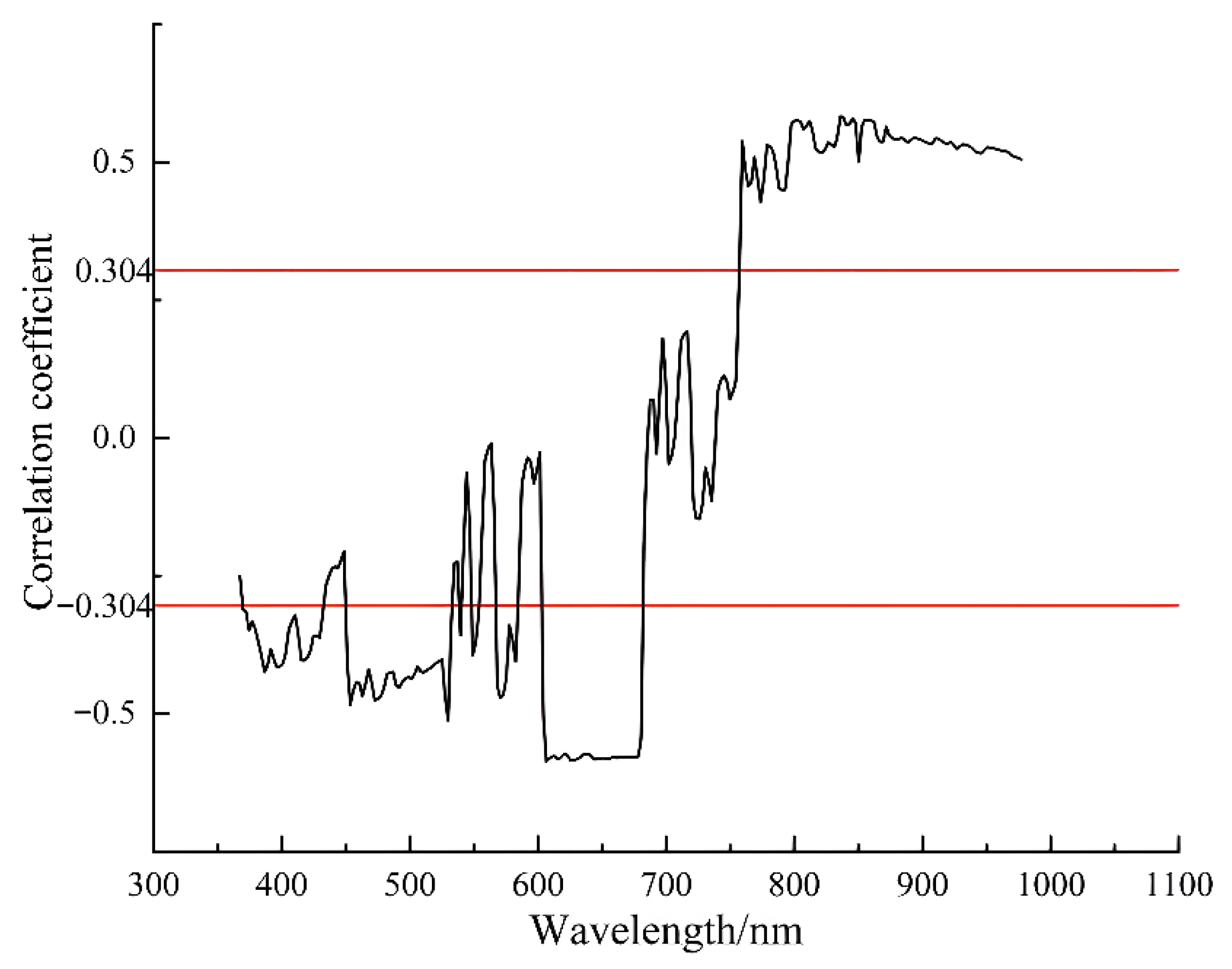
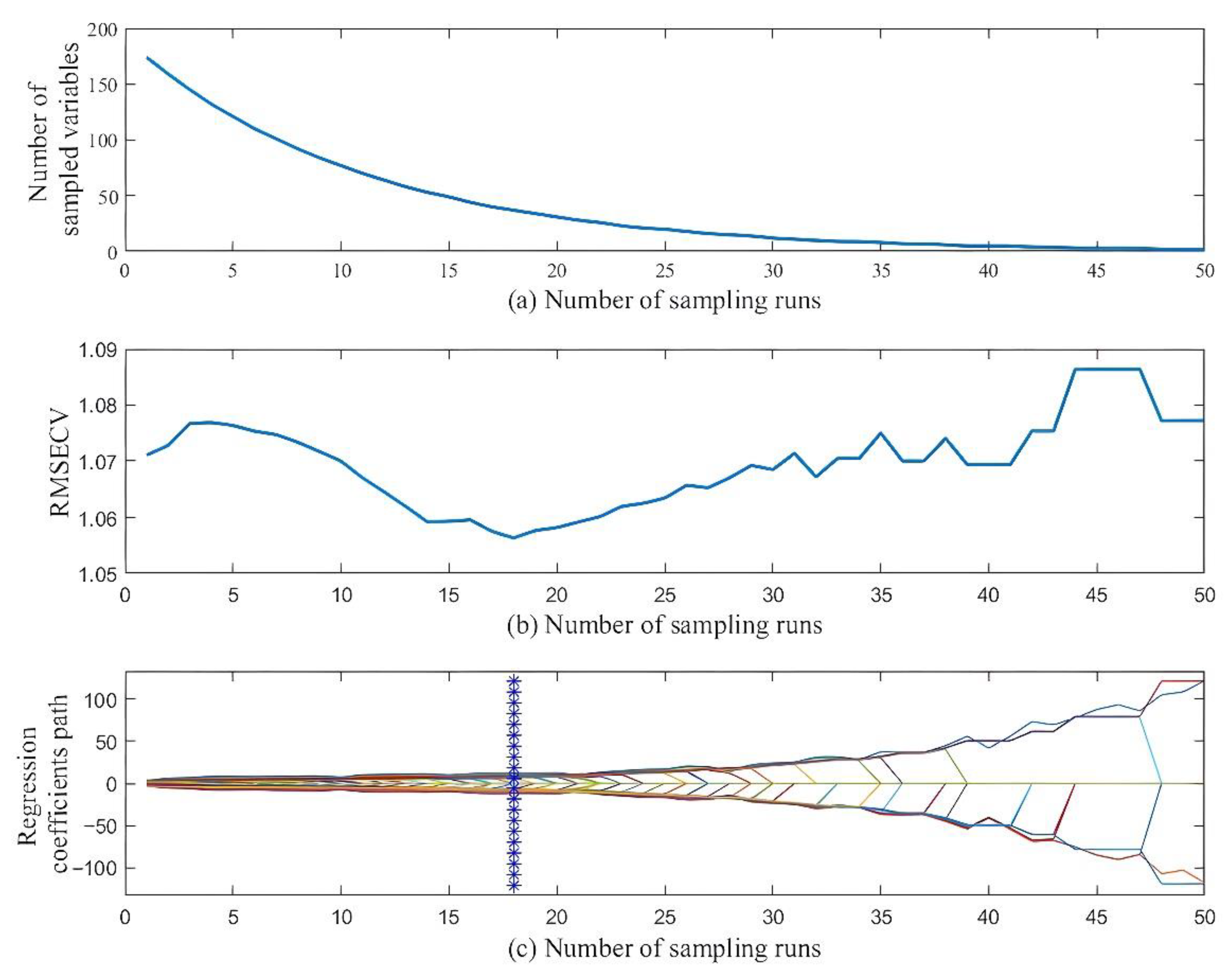
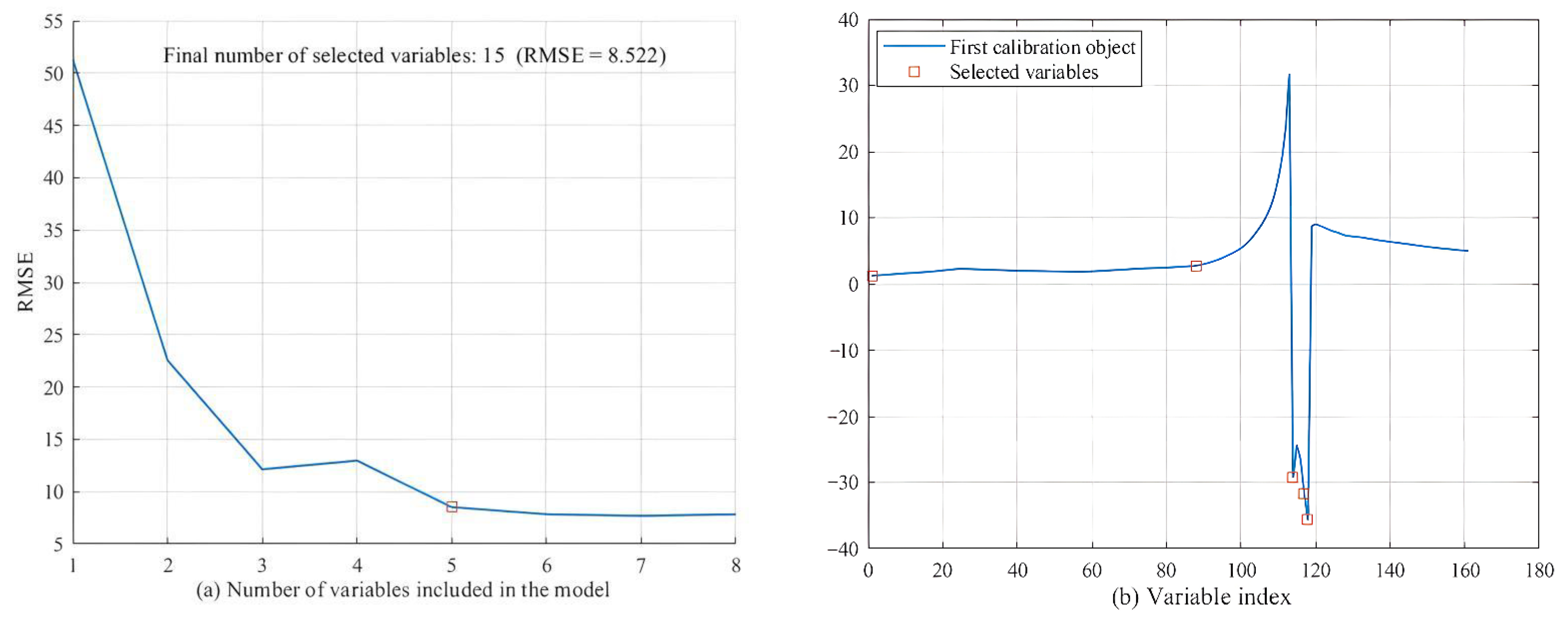
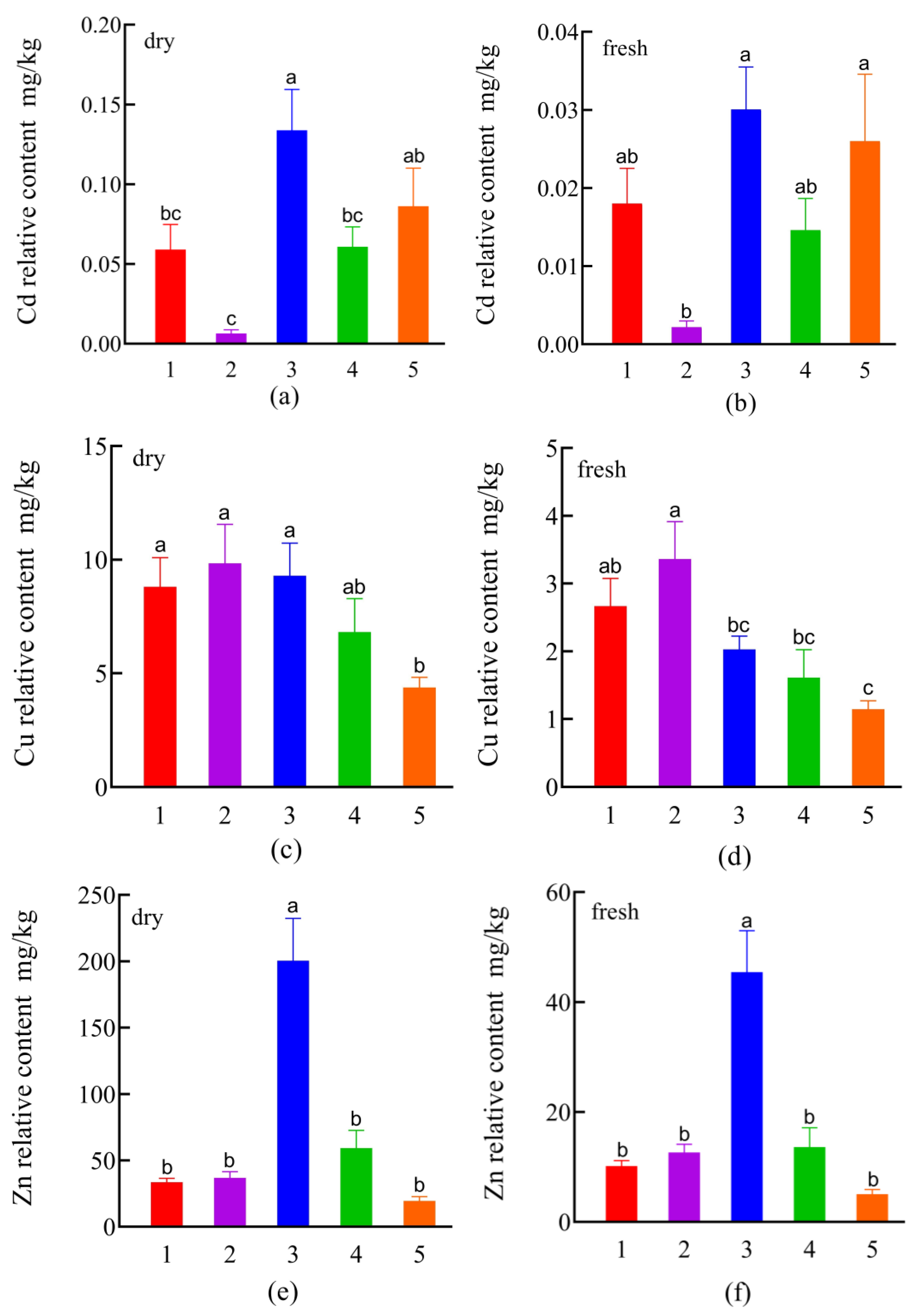

| Part of PsR | Theory of Testing | Cd Relative Accumulation Content | Cu Relative Accumulation Content | Zn Relative Accumulation Content |
|---|---|---|---|---|
| Old leaf | F-test | 0.005 | 0.052 | 0.015 |
| t-test | 0.037 | 0.000 | 0.000 | |
| Young leaf | F-test | 0.061 | 0.019 | 0.022 |
| t-test | 0.109 | 0.006 | 0.001 | |
| Upper stem | F-test | 0.009 | 0.000 | 0.031 |
| t-test | 0.005 | 0.001 | 0.002 | |
| Middle stem | F-test | 0.169 | 0.023 | 0.021 |
| t-test | 0.003 | 0.009 | 0.012 | |
| Lower stem | F-test | 0.012 | 0.002 | 0.000 |
| t-test | 0.043 | 0.000 | 0.003 |
| Prediction Index | EEMD-db3 | SG | sym3 | sym5 | MSC |
|---|---|---|---|---|---|
| Cd in the dry state | −0.681 | 0.623 | 0.613 | 0.612 | 0.622 |
| Cu in the dry state | −0.574 | 0.506 | −0.609 | −0.522 | 0.497 |
| Zn in the dry state | 0.887 | 0.812 | −0.784 | 0.758 | 0.811 |
| Cd in the fresh state | −0.593 | 0.605 | 0.547 | −0.544 | 0.643 |
| Cu in the fresh state | −0.631 | 0.653 | 0.630 | −0.624 | 0.651 |
| Zn in the fresh state | 0.828 | 0.803 | −0.706 | 0.683 | 0.615 |
| Prediction Index | The Process of Spectral Pretreatment | Characteristics of the Band |
|---|---|---|
| Cd in the dry state | EEMD-db3-db4-D3-SPA | 458.11, 572.89, 611.15, 840.71, 867.01 |
| SG-db2-D3-CARS | 491.59, 508.98, 510.72, 522.33, 654.19, 661.37, 666.15, 711.58 | |
| sym3-db4-D3-SPA | 548.98, 577.67, 761.8, 766.58, 965.05, 974.61 | |
| sym5-db2-D3-SPA | 522.68, 546.59, 632.67, 639.62, 919.61 | |
| MSC-db2-D3-CARS | 431.81, 493.98, 520.28, 654.19, 663.76, 675.71, 716.36 | |
| Cu in the dry state | EEMD-db3-FD | 572.89 |
| SG-log(1/R)-SPA | 534.63, 642.24, 670.93, 802.45, 924.4, 941.14 | |
| sym3-FD-SPA | 538.41, 582.46, 603.98, 692.45, 730.71, 800.05 | |
| sym5-FD | 529.85 | |
| MSC-db4-D3-SPA | 553.76, 560.93, 704.41, 716.36, 718.75 | |
| Zn in the dry state | EEMD-db3-db2-D4-SPA | 455.72, 505.94, 572.89, 666.15, 850.27, 929.18 |
| SG-FD-CARS | 505.94, 508.33, 603.98, 668.54, 670.93, 721.15, 757.01, 965.05 | |
| sym3-FD-CARS | 534.63, 537.02, 541.81, 587.24, 594.41, 601.59, 704.41 | |
| sym5-db4-D4-CARS | 534.63, 584.85, 972.22, 974.61, 977 | |
| MSC-log(1/R)-CARS | 448.55, 453.33, 479.63, 491.59, 513.11, 630.28, 680.50, 692.45, 900.49 | |
| Cd in the fresh state | EEMD-db3-log(1/R)-SPA | 374.42, 424.64, 752.22, 761.79, 905.27 |
| SG-db5-D3-CARS | 603.98, 620.72, 694.84, 907.66, 919.62, 948.31 | |
| sym3-db2-D3-CARS | 546.59, 560.93, 716.36, 819.18, 831.14, 878.96, 931.57, 974.61 | |
| sym5-db2-D3-CARS | 508.33, 639.84, 881.36, 883.75, 886.14, 922.01, 924.4 | |
| MSC-db4-D3-CARS | 436.59, 493.98, 658.97, 675.71, 702.02, 704.41, 721.15, 730.71 | |
| Cu in the fresh state | EEMD-db3-FD | 606.37 |
| SG-FD-CARS | 603.98, 615.93, 694.84, 907.66, 919.62, 931.57, 948.31 | |
| sym3-FD-CARS | 685.28, 723.54, 725.93 | |
| sym5-FD | 534.63 | |
| MSC-FD-CARS | 460.5, 537.02, 553.76, 589.63, 637.45, 642.24, 694.84, 713.97, 809.62, 828.75, 862.23, 883.75 | |
| Zn in the fresh state | EEMD-db3-db5-D4-CARS | 503.54, 505.94, 513.11, 532.23, 582.46, 587.23 |
| SG-db5-D4-CARS | 367.25, 431.81, 608.76, 737.88, 745.06, 847.88, 881.36, 943.53 | |
| sym3-db2-D4-CARS | 412.68, 577.67, 580.06, 922.01, 941.14 | |
| sym5-db3-D3-SPA | 386.38, 465.29, 525.07, 556.15, 651.8, 871.79 | |
| MSC-db3-D3-CARS | 489.2, 498.76, 515.5, 522.68, 529.85, 919.62 |
| Prediction Index | Model Type | R2 | NRMSE | RPD |
|---|---|---|---|---|
| Cd in the dry state | MSLR | 0.686 | 0.424 | 1.670 |
| MSLR | 0.751 | 0.336 | 1.560 | |
| MSLR | 0.632 | 0.568 | 1.375 | |
| MSLR | 0.584 | 0.825 | 1.271 | |
| MSLR | 0.796 | 0.580 | 1.382 | |
| Cu in the dry state | Index | 0.532 | 0.349 | 1.405 |
| MSLR | 0.492 | 0.810 | 1.193 | |
| MSLR | 0.570 | 0.459 | 1.358 | |
| Index | 0.313 | 0.500 | 1.237 | |
| MSLR | 0.338 | 0.594 | 1.051 | |
| Zn in the dry state | MSLR | 0.884 | 0.179 | 3.191 |
| MSLR | 0.873 | 0.326 | 3.333 | |
| MSLR | 0.780 | 0.341 | 2.159 | |
| MSLR | 0.750 | 0.509 | 2.113 | |
| MSLR | 0.882 | 0.429 | 1.912 | |
| Cd in the fresh state | PLS | 0.592 | 0.561 | 1.628 |
| MSLR | 0.734 | 0.382 | 2.223 | |
| MSLR | 0.561 | 0.673 | 1.252 | |
| MSLR | 0.564 | 0.630 | 1.314 | |
| MSLR | 0.764 | 0.662 | 1.176 | |
| Cu in the fresh state | Index | 0.591 | 0.598 | 1.147 |
| MSLR | 0.673 | 0.452 | 1.226 | |
| MSLR | 0.586 | 0.723 | 0.968 | |
| Index | 0.482 | 0.508 | 1.295 | |
| MSLR | 0.662 | 0.570 | 0.926 | |
| Zn in the fresh state | MSLR | 0.880 | 0.253 | 3.221 |
| MSLR | 0.847 | 0.337 | 2.896 | |
| MSLR | 0.810 | 0.303 | 2.163 | |
| PLS | 0.766 | 0.476 | 1.681 | |
| MSLR | 0.613 | 0.450 | 1.682 |
Disclaimer/Publisher’s Note: The statements, opinions and data contained in all publications are solely those of the individual author(s) and contributor(s) and not of MDPI and/or the editor(s). MDPI and/or the editor(s) disclaim responsibility for any injury to people or property resulting from any ideas, methods, instructions or products referred to in the content. |
© 2023 by the authors. Licensee MDPI, Basel, Switzerland. This article is an open access article distributed under the terms and conditions of the Creative Commons Attribution (CC BY) license (https://creativecommons.org/licenses/by/4.0/).
Share and Cite
Tang, T.; Chen, C.; Wu, W.; Zhang, Y.; Han, C.; Li, J.; Gao, T.; Li, J. Hyperspectral Inversion Model of Relative Heavy Metal Content in Pennisetum sinese Roxb via EEMD-db3 Algorithm. Remote Sens. 2023, 15, 251. https://doi.org/10.3390/rs15010251
Tang T, Chen C, Wu W, Zhang Y, Han C, Li J, Gao T, Li J. Hyperspectral Inversion Model of Relative Heavy Metal Content in Pennisetum sinese Roxb via EEMD-db3 Algorithm. Remote Sensing. 2023; 15(1):251. https://doi.org/10.3390/rs15010251
Chicago/Turabian StyleTang, Ting, Canming Chen, Weibin Wu, Ying Zhang, Chongyang Han, Jie Li, Ting Gao, and Jiehao Li. 2023. "Hyperspectral Inversion Model of Relative Heavy Metal Content in Pennisetum sinese Roxb via EEMD-db3 Algorithm" Remote Sensing 15, no. 1: 251. https://doi.org/10.3390/rs15010251
APA StyleTang, T., Chen, C., Wu, W., Zhang, Y., Han, C., Li, J., Gao, T., & Li, J. (2023). Hyperspectral Inversion Model of Relative Heavy Metal Content in Pennisetum sinese Roxb via EEMD-db3 Algorithm. Remote Sensing, 15(1), 251. https://doi.org/10.3390/rs15010251








